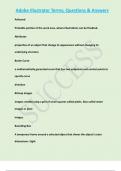Samenvatting
Summary lecture notes, Q and A's and practice assignment Empirical Methods in Finance
- Instelling
- Tilburg University (UVT)
Document is full of lecture notes, summarizing teacher's comment as well as Q and A contents (also polls, etc.). The summary is quite long due to screenshots from slides from examples.
[Meer zien]







